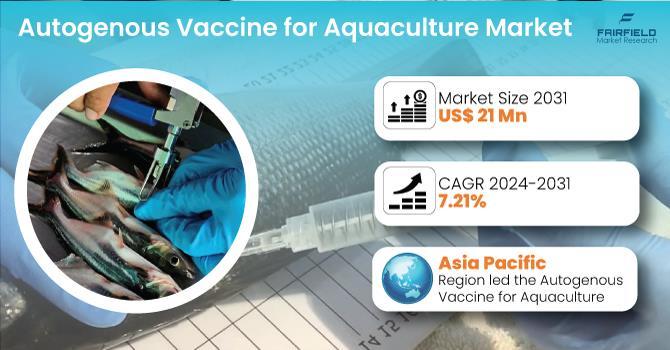Global autogenous vaccine for aquaculture market is on a trajectory of substantial growth, poised to reach a valuation of US$21 million by the year 2031. This significant surge marks an impressive increase from the US$12.9 million attained in 2024. The market's revenue is expected to exhibit a remarkable rate of expansion, boasting an estimated Compound Annual Growth Rate (CAGR) of nearly 7.21% during the period spanning from 2024 to 2031.

View Market Insights :
https://www.fairfieldmarketresearch.com/report/autogenous-vaccine-for-aquaculturemarket
Key Growth Drivers
The growth in the Global autogenous vaccine for aquaculture market can be attributed to several key factors. Firstly, there is a notable rise in consumer demand for seafood, which has led aquaculture farms to seek effective disease prevention solutions such as autogenous vaccines tailored to specific pathogens. Furthermore, advancements in vaccine technology, coupled with increased investment in Research and Development (R&D) by key players like IDT Biologika, Ceva Biovac, and others, are expected to drive innovation and adoption of autogenous vaccines.
Major Growth Determinants
Several determinants are fueling the growth of the Global autogenous vaccine for aquaculture market. Increased demand for sustainable aquaculture practices, driven by growing concerns over environmental impact and disease management, is a significant factor. Autogenous vaccines offer a tailored approach to disease
prevention, reducing the need for antibiotics and chemicals, thus aligning with the industry's sustainability goals.
Moreover, the demand for customised disease management solutions is rising. Autogenous vaccines can be developed specifically for particular aquaculture operations, targeting prevalent pathogens unique to each farm or region. This customisation enhances efficacy, leading to better disease control and higher productivity.
Regulatory support and industry adoption also play crucial roles in market growth. Regulatory agencies are increasingly recognising the importance of autogenous vaccines in aquaculture disease management, driving their adoption among aquaculture producers.
Major Growth Barriers
Despite the promising growth outlook, the Global autogenous vaccine for aquaculture market faces several barriers. Stringent regulatory hurdles, including lengthy approval processes, can impede market growth. Technological challenges in developing effective autogenous vaccines tailored to specific pathogens also pose significant obstacles. Additionally, limited awareness and adoption among aquaculture producers hinder market expansion.
Key Trends and Opportunities
Several key trends and opportunities are shaping the Global autogenous vaccine for aquaculture market. The growing focus on sustainability across industries presents an opportunity for market players to align their offerings with eco-friendly practices. Increasing technology intervention, rising focus on effective disease prevention, and expansion in demand for seafood are other notable trends driving market growth.
Regional Frontrunners
In terms of regional dynamics, Asia Pacific leads the pack, boasting the world's largest aquaculture industry. North America emerges as a prominent market, driven by stringent regulations and a focus on eco-friendly seafood production. Europe also boasts a significant market, supported by a well-developed regulatory framework and high consumer awareness of safe food practices.
Competitive Landscape
The competitive landscape of the Global autogenous vaccine for aquaculture market is characterised by a blend of established pharmaceutical giants and specialised players. Key players such as IDT Biologika GmbH, Ceva Biovac, Zoetis (PHARMAQAS), and others are focusing on continuous research and development efforts, strategic collaborations, and product differentiation to maintain their competitive edge and foster growth.
